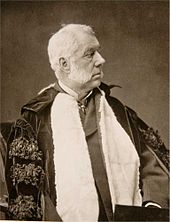Oxenfoord Castle
Oxenfoord Castle , also obsolete Oxenfurd Castle or Oxenfuird Castle , is a castle near the Scottish village of Pathhead in the Council Area Midlothian . It is a few hundred yards west of the Tyne that separates the property from that of the Preston Hall mansion . In 1971 the building was included in the Scottish List of Monuments in the highest category A. Furthermore, a bridge on the property is also independently classified as a Category A structure. The entire property is on the Scottish Landscaping Register . In two of six categories, the highest rating “outstanding” was awarded.
history
Over the centuries the lands of Oxenfoord saw different masters. Between the 12th and 14th centuries, they were owned by the Riddell clan . This was followed by the Murray clan and it was finally the Makgill clan who built a tower house there in the 16th century . James Makgill was installed as the 1st Viscount of Oxfuird in 1651 . His son and successor Robert is probably responsible for the initial design of the property and laid the foundation stone for today's park. Since Robert Magkill did not leave a male heir, Oxenfoord Castle was inherited within the family. In 1760, Elizabeth, the great-granddaughter of James Makgill, married John Dalrymple . In 1779 she inherited the property.
In the early 1780s, Dalrymple commissioned his friend Robert Adam to build what is now Oxenfoord Castle and to redesign the park. During the work, parts of the Tower House were preserved and integrated into the castle. Oxenfoord Castle was completed in 1783. John Dalrymple, 8th Earl of Stair inherited the property in 1810. In 1842 he commissioned the Scottish architect William Burn to expand the castle. During this construction phase, the size of the building almost doubled. Oxenfoord Castle was inherited within the family. John Dalrymple, 10th Earl of Stair , who owned the property in the 1860s, focused on building Lochinch Castle in Wigtownshire and neglected Oxenfoord Castle.
It was not until 1931 that the well-known story of Oxenfoord Castle continued. That year the property was rented to run the Oxenfoord Castle School . After it was closed in 1993, the castle went into private ownership. It can be rented today for events and weddings.
Oxenfoord Viaduct
As early as 1760, John Dalrymple reported his wish to upgrade the property with a bridge. When he inherited the castle, Dalrymple had appropriate plans drawn up. Well-known bridge builder Alexander Stevens submitted a design that had an estimated cost of around £ 180. As part of the construction work on Oxenfoord Castle, Robert Adam revised the submitted plan and the Oxenfoord Viaduct was built around 1783.
The Oxenfoord Viaduct, also Oxenfoord Bridge , is a masonry viaduct about 50 m north of the castle. The three- arched arch bridge leads the main access road to Oxenfoord Castle over a steep gorge. The central arch of the sandstone structure is higher than the flanking one. The parapet is reinforced with battlements in the style of the castle.
Individual evidence
- ↑ a b Listed Building - Entry . In: Historic Scotland .
- ↑ a b c Listed Building - Entry . In: Historic Scotland .
- ↑ a b c Garden and Designed Landscape - entry . In: Historic Scotland .
- ↑ Information on Oxenfoord Castle
Web links
- Oxenfoord Castle website
- Entry in the Gazetteer for Scotland
- Entry on Oxenfoord Castle in Canmore, Historic Environment Scotland database
Coordinates: 55 ° 52 ′ 43.4 " N , 2 ° 58 ′ 45.8" W.


